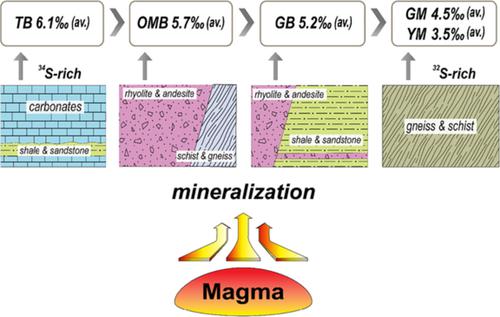当前位置:
X-MOL 学术
›
Resour. Geol.
›
论文详情
Our official English website, www.x-mol.net, welcomes your feedback! (Note: you will need to create a separate account there.)
Regional variations of sulfur isotope compositions for metallic deposits in South Korea
Resource Geology ( IF 1.4 ) Pub Date : 2021-04-06 , DOI: 10.1111/rge.12259 Jaeguk Jo 1 , Youngah Jeong 1 , Dongbok Shin 1
Resource Geology ( IF 1.4 ) Pub Date : 2021-04-06 , DOI: 10.1111/rge.12259 Jaeguk Jo 1 , Youngah Jeong 1 , Dongbok Shin 1
Affiliation

|
Southern Korean peninsula comprises five major geotectonic provinces, throughout which various metallic deposits are distributed. We reviewed sulfur isotope data (n = 1,574) of sulfide minerals collected from previous works for 177 metallic deposits in the provinces to interpret the sulfur isotope characteristics of each province, comprising different wall rocks and geologic settings. The averaged δ34S values of each metallic deposit associated with Precambrian metamorphic rocks and Jurassic granitoids in the Gyeonggi massif and Yeongnam massif range from −7.1 to +10.3‰ (av. +4.5‰) and from −3.6 to +7.8‰ (av. +3.5‰), respectively. The Taebaeksan basin produced the highest δ34S value among the five, −0.4 to +13.2‰ (av. +6.1‰). This was influenced by sulfate sulfur derived from marine carbonate host rock. The Okcheon metamorphic belt, comprising metasedimentary and metavolcanics rocks, shows an isotope range from +1.9 to +8.3‰ (av. +5.7‰). The sulfur isotope distribution of the Gyeongsang basin with a range from −1.2 to +11.7‰ (av. +5.2‰) can be divided into two zones: higher δ34S values from the inner zone related to the volcanic rocks and magnetite-series Cretaceous granitoids, and lower δ34S values from the outer zone related to the organic-rich sedimentary rocks. Sulfur isotope variations of metallic deposits in each geotectonic province were mainly influenced by igneous sulfur and inherent wall rock sulfur sources, 32S-enriched sedimentary sulfur (e.g., Precambrian metasedimentary rocks and biogenic sulfur-rich sedimentary rocks), and 34S-enriched seawater sulfur (e.g., carbonates and acid to intermediate volcanic rocks). These wall rocks also contributed to the changes in δ34S values for granitoid rocks and metallic deposits by time, ore genetic type, and ore species in South Korea.
中文翻译:

韩国金属矿床硫同位素组成的区域变化
南朝鲜半岛由五个主要的大地构造省组成,分布着各种金属矿床。我们回顾 了从以前工作中收集的各省 177 个金属矿床的硫化物矿物的硫同位素数据 ( n = 1,574),以解释每个省的硫同位素特征,包括不同的围岩和地质环境。京畿地块和岭南地块中与前寒武纪变质岩和侏罗纪花岗岩相关的每个金属矿床的平均 δ 34 S 值范围为 -7.1 至 +10.3‰ (av. +4.5‰) 和 -3.6 至 +7.8‰ (av. . +3.5‰),分别。太白山盆地的δ 34最高五位之间的S值,-0.4到+13.2‰(平均+6.1‰)。这受到来自海相碳酸盐母岩的硫酸盐硫的影响。由变沉积岩和变质火山岩组成的玉泉变质带显示同位素范围为 +1.9 至 +8.3‰(平均 +5.7‰)。庆尚盆地硫同位素分布范围为−1.2 至 +11.7‰ (av. +5.2‰) 可分为两个区域:较高的 δ 34 S 值来自与火山岩和磁铁矿系列相关的内部区域白垩纪花岗岩,以及与富含有机质沉积岩相关的外部区域的较低 δ 34 S 值。各大地构造省金属矿床硫同位素变化主要受火成岩硫和围岩固有硫源的影响,32富硫沉积硫(例如前寒武纪变质沉积岩和生物成因富硫沉积岩)和34富硫海水硫(例如碳酸盐和酸性至中级火山岩)。这些围岩还导致了韩国花岗岩和金属矿床的δ 34 S 值随时间、矿石成因类型和矿石种类的变化。
更新日期:2021-06-05
中文翻译:

韩国金属矿床硫同位素组成的区域变化
南朝鲜半岛由五个主要的大地构造省组成,分布着各种金属矿床。我们回顾 了从以前工作中收集的各省 177 个金属矿床的硫化物矿物的硫同位素数据 ( n = 1,574),以解释每个省的硫同位素特征,包括不同的围岩和地质环境。京畿地块和岭南地块中与前寒武纪变质岩和侏罗纪花岗岩相关的每个金属矿床的平均 δ 34 S 值范围为 -7.1 至 +10.3‰ (av. +4.5‰) 和 -3.6 至 +7.8‰ (av. . +3.5‰),分别。太白山盆地的δ 34最高五位之间的S值,-0.4到+13.2‰(平均+6.1‰)。这受到来自海相碳酸盐母岩的硫酸盐硫的影响。由变沉积岩和变质火山岩组成的玉泉变质带显示同位素范围为 +1.9 至 +8.3‰(平均 +5.7‰)。庆尚盆地硫同位素分布范围为−1.2 至 +11.7‰ (av. +5.2‰) 可分为两个区域:较高的 δ 34 S 值来自与火山岩和磁铁矿系列相关的内部区域白垩纪花岗岩,以及与富含有机质沉积岩相关的外部区域的较低 δ 34 S 值。各大地构造省金属矿床硫同位素变化主要受火成岩硫和围岩固有硫源的影响,32富硫沉积硫(例如前寒武纪变质沉积岩和生物成因富硫沉积岩)和34富硫海水硫(例如碳酸盐和酸性至中级火山岩)。这些围岩还导致了韩国花岗岩和金属矿床的δ 34 S 值随时间、矿石成因类型和矿石种类的变化。



























 京公网安备 11010802027423号
京公网安备 11010802027423号